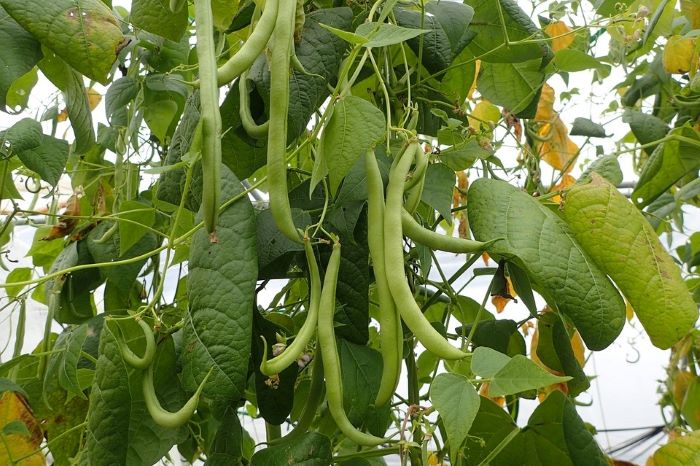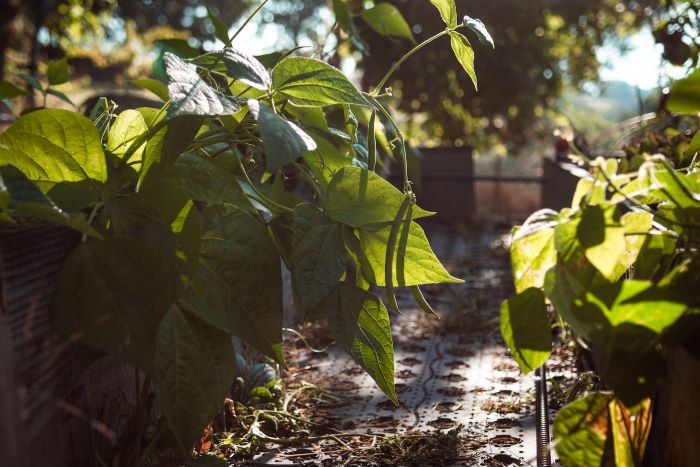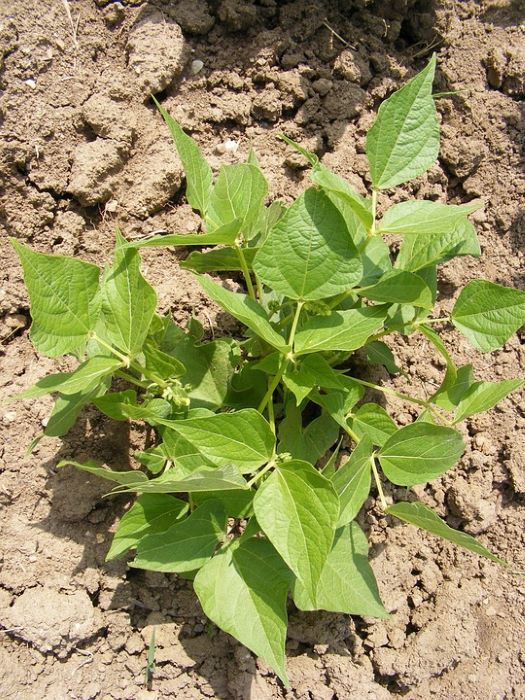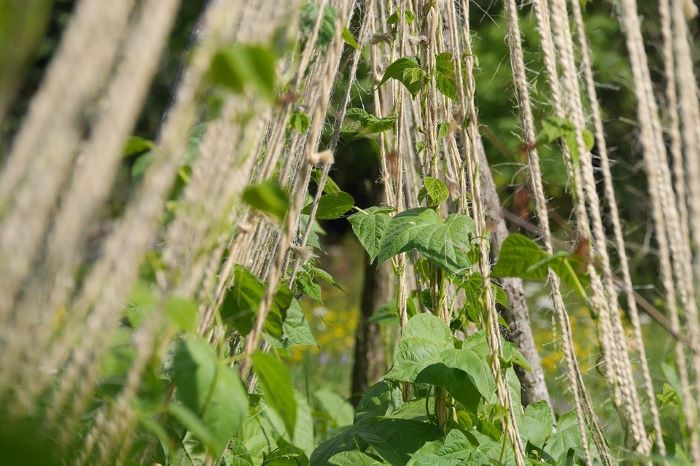Green beans are a popular vegetable crop that is easy to grow in a home garden. They are typically planted in the spring and can produce a bountiful harvest in the summer. However, sometimes gardeners may notice their green bean plants turning yellow, which can be a cause for concern.

Table of Contents
Why Are My Green Bean Plants Turning Yellow?
Yellow leaves on a bean plant typically indicate that the plant is experiencing some sort of stress. The most common causes are soil nutrient deficiency and poor soil conditions, insufficient sunlight, incorrect watering habits, temperature issues, diseases, and pests.
In this article, we’ll explore why green bean plants turn yellow and provide tips on how to fix the problem.
Related: Bean Plants Dying? 7 Causes and Solutions
1. Soil Nutrient Deficiency
A nutrient deficiency is one of the most common causes of yellowing green bean plants. Nitrogen, phosphorus, potassium, and magnesium, are essential nutrients plants need to grow and produce fruit. If any of these nutrients are lacking, it can lead to yellowing leaves.
If you notice the leaves on your green bean plants have yellow and brown spots, that is a sign that your plant is lacking nutrients. Luckily nutrient deficiency is an easy fix. You can check what nutrients your soil is lacking by using a soil home testing kit like this one.
Once you know which nutrients your soil is lacking, simply add some. Remember not to add too much nitrogen. If you add too much nitrogen your plant will produce lots of leaves but hardly any fruit.
I like to make sure my soil starts with plenty of healthy compost and I an organic fertilizer to make sure my bean plants have all the nutrients they’ll need throughout the growing season.
2. Soil Conditions
Closely related to a lack of soil nutrients, another reason the leaves on your green bean plants are turning yellow could be due to the soil conditions in general.
In my early days as a home gardener, I had no understanding of soil conditions. It was only once I began pulling up deformed parsnips and my tomato plants began yellowing did I start to understand just how important soil is.
As it turns out, soil conditions are extremely important, and every plant has a soil preference.
Plant green beans in well-draining, sandy, and silty loam soils. However, green beans will grow in most soil types so long as it is not ladened with clay.
If your soil has too much clay, you can add agricultural sand to it to help with drainage. If your soil is too sandy, you can add organic matter to it.
In addition to soil types, the pH balance of the soil is a factor that could be causing your green bean plants to yellow. The pH balance of your soil indicates the balance of essential nutrients present. Green beans like neutral or slightly alkaline soil with a pH level between 5.5 and 7. If you aren’t sure what the pH level of your soil is, you can use a soil pH monitor like this one.
If your pH level is too high you can use a soil acidifier or sulfur to bring the pH level below 7. If the pH level is too low, you can use a liming agent. Additionally, it is important to keep your green bean plants warm. The soil temperature around your plants should not drop below 50°F. Applying mulch around your plants should do the trick.
3. Insufficient Sunlight

Insufficient sunlight is another common reason your green bean plant is turning yellow. As green beans grow in warmer weather, they require between 6 and 8 hours of sunlight each day to thrive.
One of the effects of plants not receiving the correct amount of sunlight they need is that they are unable to photosynthesize. When plants don’t photosynthesize, they cannot produce the green pigment called chlorophyll. This helps them to absorb the energy from the sun.
The result is that the lower leaves of the bean plant will start to turn yellow. The rest of the leaves will follow suit and eventually, the plant will die.
When planting your green beans, ensure you plant them in a spot that receives the right amount of sunlight per day.
4. Incorrect Watering Habits
Watering habits play a huge role in the health of your garden. Both overwatering and underwatering can cause yellowing on your green bean plants.
The way to know if overwatering or underwatering is your problem is by checking the soil. If your soil is damp a few inches below the surface, then the issue is overwatering. If it is dry, the issue is underwater.
Underwatering

Underwatering is a common problem that can affect the health and growth of green bean plants. If your plants are not receiving enough water they will begin to wilt. This is because the plant is not able to take up enough water to keep its leaves hydrated and upright.
In addition to wilting, underwatered green bean plants may also experience yellowing leaves. This is because the plant is not receiving enough water to take up the necessary nutrients to keep its leaves green and healthy.
Monitoring the soil moisture level is important for preventing underwatering of green bean plants. Water the plants when the soil is dry to the touch. Depending on the climate and conditions in your area, this may mean watering your green beans every 2-3 days.
Providing a layer of organic mulch around the base of the plants can also help retain moisture in the soil and reduce the need for frequent watering. I have found adding mulch around the base of green bean plants to be a game changer. The soil stays damp for longer, reducing watering times.
Overwatering
Overwatering green bean plants, like underwatering, will cause yellowing of the plant. When a plant is overwatered it suffocates, meaning it can not get the nutrients it needs. Adding to this, overwatering can lead to a disease called root rot. As the name suggests, root rot causes the root system of the plant to rot, eventually killing the bean plant.
To avoid overwatering your green bean plants, only water the plants when the soil is dry to the touch. Planting your green beans in well-draining soil can also help prevent overwatering.
If you have unintentionally overwatered your plants, give the soil a few days to dry out. Only water your bean plants if the soil is dry at 2-3 inches below the surface.
5. Temperature Issues

Green bean plants can also turn yellow due to environmental stress such as the climate. Green beans should be planted in spring when the threat of frost and low temperatures has disappeared.
Green beans will grow in temperatures ranging between 65-85°F (18-30°C). Anything above this, and the leaves of your bean plants can burn. When leaves burn they turn yellow, but it is slightly different from the yellowing we have been discussing. Leaves that have been burned look scorched.
While in low temperatures, the bean plant’s growth will be stunted and it will turn yellow.
To prevent your plants from burning, cover them with a shade cloth. If the temperatures are set to drop, cover your plants with agricultural fleece.
6. Diseases
Several diseases can also cause green bean plants to turn yellow. These diseases are often caused by bacteria, viruses, fungi, or pests and can spread quickly from plant to plant.
Bacterial Diseases
Bacterial diseases present with yellowing of the leaves with a noticeable wet spot. Bacterial diseases usually present with disfigured bean pods in addition to brown spots with a yellow ring around them. Bacterial diseases that affect green bean plants are common blight, halo blight, and bacterial brown spot.
Bacterial diseases spread through moisture, so to stop the spread of the disease do not come into contact with your plant while it is wet. Sadly once a plant is infected with a bacterial infection, it will need to be removed and destroyed.
Once you have destroyed the affected plants, make sure you sterilize your gardening equipment with a mixture of 1 part bleach to 5 parts water.
Viral Diseases
Viral diseases which cause yellow discoloration of green bean plants are common. In particular, the mosaic viruses such as the bean common mosaic virus (BCMV), and yellow mosaic virus (BYMV) are two diseases to which the plant is extremely susceptible.
BCMV and BYMV are both transmitted by aphids. They cause a mosaic pattern on the leaves of the plant. Infected plants may also have stunted growth and reduced yield. There is no cure for mosaic viruses, so it is important to remove infected plants and avoid planting in infected soil.
Fungi
Several fungal diseases can cause the leaves of the green bean plant to turn yellow and eventually die. These diseases are Alternaria leaf spot, damping-off, white mold, bean rust, and fusarium root rot.
If your plant has a fungal infection, it is best to remove it, destroy it and then replace the soil with clean soil. To try and prevent fungal infections, avoid overhead water systems or irrigation, and do not plant beans too close together.
7. Pests
Yellowing leaves can also be a sign of a pest infestation, which green bean plants are often the target of. The first sign that your plants have a pesky pest problem is small holes in the plant’s leaves.
Pests such as aphids, cutworms, vegetable leaf miners, Mexican bean beetle, spider mites, potato leafhopper, and thrips are all pests that favor green beans. An infestation of pests can cause the leaves of your green bean plant to wrinkle, turn yellow and drop off. Or pests can cause the plant’s leaves to turn yellow and for the plant to become deformed.
Once you have identified which pest is wreaking havoc on your green bean crop, you will be able to treat it. Treatment usually involves a good strong blast of cold water to dislodge the pests, followed by an application of neem oil or a mixture of dish soap and water.
Further Reading:
